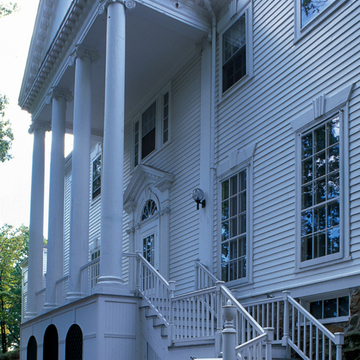George P. Fernald designed and built this imposing Neo-Colonial house atop Rock Hill on land he acquired with his brother, Albert. Although both men were architects, George is known primarily for his Colonial Revival murals in houses designed by Little and Browne, while he was their draftsman. These murals include those in the Joseph Thorpe House (BS14), as remodeled for Mrs. Ole Bull, and in the renovated 1780s Hamilton House in South Berwick, Maine (1905–1906). Fernald reused here interior elements from a Federal-period house in Providence, Rhode Island. The portico of the White House in Washington, D.C., inspired the pedimented two-story portico, originally flanked by curved staircases; and the ballroom of the Count Rumford House (WO6) in Woburn provided a model for the one-and-a-half-story barrel-vaulted ceiling of the original
You are here
George P. Fernald House
1894, George P. Fernald. 12 Rock Hill St.
If SAH Archipedia has been useful to you, please consider supporting it.
SAH Archipedia tells the story of the United States through its buildings, landscapes, and cities. This freely available resource empowers the public with authoritative knowledge that deepens their understanding and appreciation of the built environment. But the Society of Architectural Historians, which created SAH Archipedia with University of Virginia Press, needs your support to maintain the high-caliber research, writing, photography, cartography, editing, design, and programming that make SAH Archipedia a trusted online resource available to all who value the history of place, heritage tourism, and learning.


